The BLS July JOLTS report, or Job Openings and Labor Turnover Survey shows there are 3.1 official unemployed per job opening and this has been the same story for the last six months. Job openings declined by -4.7% from the previous month to a total of 3,689,000. Hirings increased 2.3% to 4.419 million. Real hiring has only increased 22% from June 2009. Job openings are still below pre-recession levels of 4.7 million. Job openings have increased 69% from July 2009. Every month JOLTS reports the same bleak labor market conditions with little improvement. There is never enough actual hiring in addition to not enough openings.
There were 1.8 official unemployed persons per job opening at the start of the recession, December 2007. Below is the graph of the official unemployed per job opening and we see a slight uptick for July. The official unemployed ranked 11.5 million in July 2013.

If one takes the official broader definition of unemployment, or U-6, the ratio becomes 6* unemployed people per each job opening. The July U-6 unemployment rate was 14%. Below is the graph of number of unemployed, using the broader U-6 unemployment definition, per job opening.

JOLTS reports any job opening, regardless of pay. There is no information on the ratio of part-time openings to full-time ones. The rates below mean the number of openings, hires, fires percentage of the total employment. Openings are added to the total employment for it's ratio. The hires rate changes for industry sectors with currently leisure & hospitality, the lowest paying jobs of all, having the highest rates.
- Openings rate: 2.6%
- Hires rate: 3.2%
- Separations rate: 3.0%
- Fires & layoffs rate: 1.1%
- Quits rate: 1.7%
- Other rate: 0.2%
Graphed below are raw job openings. Job openings are still below the 4.7 to 4.3 million levels of 2007. Retail trade job openings showed a decline of 50,000 job openings in a month, or a drop of -10.6%. This is working at your big box marts, clothing stores and so on, Construction dropped by 20,000 job openings, a monthly -16.7% decline.

Since the July 2009 trough, actual hires per month have only increased 22%. This is simply terrible and the most important indicator in our view for employers are clearly refusing to increase hiring, across the board and thus not recover from our jobs crisis. Businesses can say there are job openings, but if they do not hire an American and fill it, what's the point? The truth is business are refusing to hire Americans and this is while profits are at roaring highs. Additionally the hires rate is 0.1 percentage point higher than it was a year ago, in other words, static.
There is variance per occupation sector on hiring, needless to say. While retail trade openings fell, their hiring increased by 36,000. a 6.2% increase. Health care and social assistance hires increased by 43,000, or 10.7%.

Graphed below are total job separations, 4.109 million, a decrease of -2.8% from the previous month. The term separation means you're out of a job through a firing, layoff, quitting or retirement.
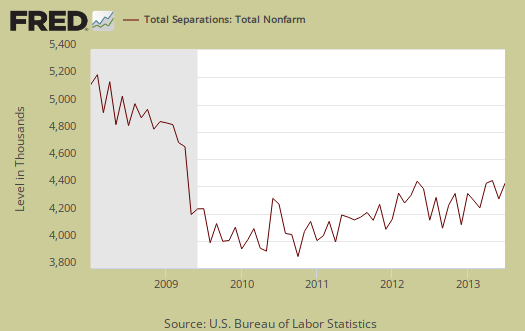
Layoffs and firings were 1.513 million, a decline of -5.6% from June. Below is a graph of just layoffs and firings. One can see from labor flows while businesses are not trashing their workforce so much, they are also not adding to their payrolls. Labor flows means the way people get hired, stay at a job, quit, get fired, get another job and so on.
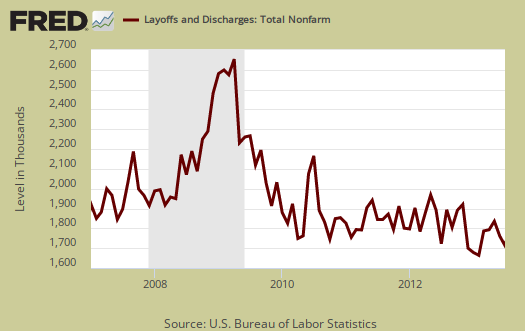
Graphed below are openings separations and hires levels, so we can compare the types of labor flows. While layoffs have declined to pre-recession levels, it is the flat line hires (blue) that is the problem, beyond not enough job openings (red) for the unemployed. There is simply not enough hiring going on to get people back to work. Anyone who claims a labor shortage is also easily disproved by these figures. A labor shortage would imply more job openings than unemployed available to fill them.
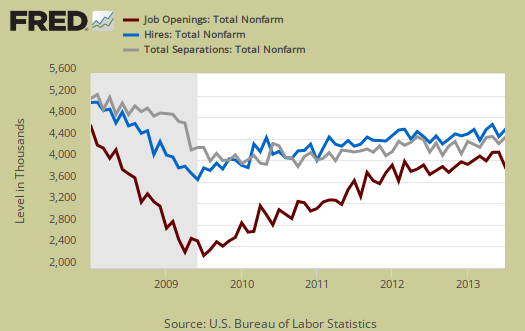
One thing rarely mentioned in the press is the pathetic annual job gains. Permanent job gains are consistently below 2 million with these persistently high unemployment levels means the job crisis seemingly is without end and employment is not permanent. Note the contrast between the BLS payroll figures. The reason this figure is lower is labor flows. People are being separated from their jobs, so one can have job growth yet if people are then fired later, by labor flows that loss results in less net employment gains.
Over the 12 months ending in July 2013, hires totaled 52.1 million and separations totaled 50.2 million, yielding a net employment gain of 1.9 million. These figures include workers who may have been hired and separated more than once during the year.
Graphed below are people who quit their jobs minus those who were fired and laid off. The lower the bar on the below graph, the worse labor conditions are. The number of quits were 2.268 million, also no change, a 2.9% increase from last month. People quit their current jobs often to obtain better ones. People feeling free enough to leave their current positions is considered a positive labor market sign. . That said, quit statistics are still way below pre-recession levels of 2.9 million, although quits has increased 42% in the private sector from the September 2009 low of 1.5 million.
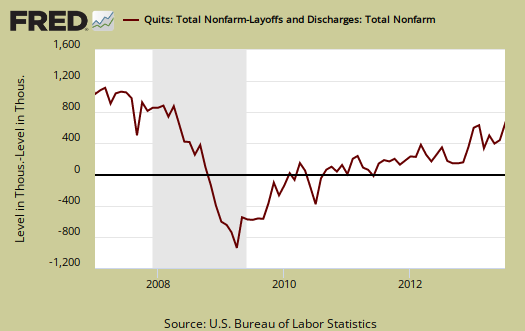
Below is a graph of the quits to layoffs ratio, currently at 1.5. This ratio of people who quit their jobs vs. those who were fired gives an indicator of worker churn as well as if there might be a shortage. If the ratio is below 1.0, this means more people are being laid off and fired than people who quit. When the ratio is much higher, this means more people quit their jobs and thus implies there is better opportunity elsewhere and workers feel free enough to move on. The quits to fires ratio was 1.8 in 2006. The health care and social assistance sector has remained above 1.0 in this ratio, implying there are plenty of jobs. The construction industry, on the other hand, has a quits to layoffs ratio of below 1.0, implying getting fired from your construction job is routine. Here again we see a bad labor market and people don't quit because there aren't enough better opportunities.
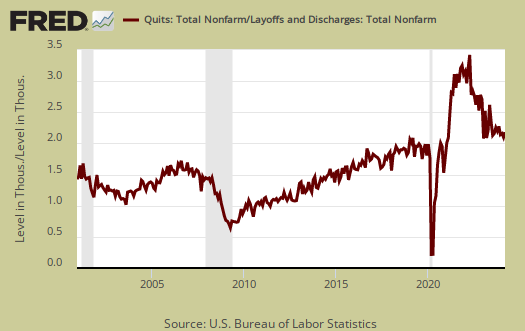
For the JOLTS report, the BLS creates some fairly useful graphs beyond the above and they have oodles of additional information in their databases, broken down by occupational area. That said, one doesn't know if the openings are quality jobs from the JOLTS statistics. The St. Louis Federal Reserve also had loads of graphing tools for JOLTS.
The JOLTS takes a random sampling of 16,000 businesses and derives their numbers from that. The survey also uses the CES, or current employment statistics, not the household survey as their base benchmark, although ratios are coming from the household survey, which gives the tally of unemployed.
The July 2013 unemployment rate was 7.4%. JOLTS includes part-time jobs and does not make a distinction between part-time, full-time openings. A job opening reported to the survey could literally be take out the trash twice a week and be counted. This is a shame, it would be nice to know a little more about the quality of these new opportunities. Here are our past JOLTS overviews, unrevised.
* is defined as the official unemployed plus people who are in part-time jobs for economic reasons plus the marginally attached. The marginally attached
, are officially not part of the civilian labor force,
, and also not seasonally adjusted. The above graph was created by the seasonally adjusted levels of the unemployed, part-time for economic reasons and the marginally attached, raw totals. Another way to calculate this figure is:
where

Recent comments